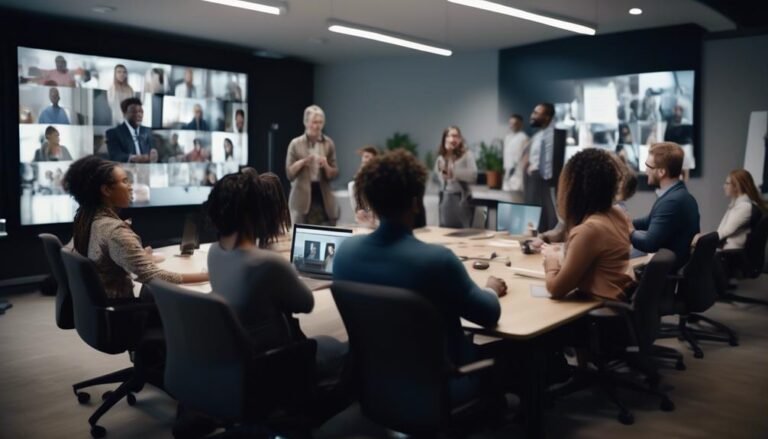What Is Facilitation?
Exploring the concept of facilitation unveils a world of intricacies and nuances that extend far beyond mere guidance. The art of facilitation transcends conventional teaching methods, acting as a catalyst for transformative learning experiences.
As we navigate through the complexities of facilitation, we begin to unravel its profound impact on individual growth, team collaboration, and organizational success. Stay tuned to unravel the layers of facilitation's influence and discover how it shapes the landscape of professional development and learning environments.
Key Takeaways
- Facilitation guides learners towards specific outcomes effectively.
- Facilitators use active listening, open-ended questions, and problem-solving techniques.
- Facilitation enhances learning through group dynamics and active participation.
- Facilitators create a safe environment for constructive discussions and conflict resolution.
Definition of Facilitation
Facilitation, as a crucial skill in guiding group learning dynamics and processes, is a technique employed to assist learners in acquiring, retaining, and applying knowledge and skills.
The benefits of facilitation include enhanced engagement, improved collaboration, and deeper understanding among participants. However, facilitation also presents challenges such as managing group dynamics, addressing conflicting viewpoints, and maintaining focus on learning objectives.
The impact of effective facilitation can lead to enriched learning experiences, increased knowledge retention, and the development of critical thinking skills. Ultimately, the outcomes of facilitation are reflected in the growth and achievements of learners as they apply newly acquired knowledge and skills in real-world scenarios.
Importance in Learning Environments
In learning environments, the significance of effective facilitation becomes evident through its ability to nurture collaborative engagement and foster a deeper understanding among participants. Facilitation plays a crucial role in promoting collaborative learning and interactive engagement, creating an environment where individuals can actively participate, exchange ideas, and build upon each other's knowledge. Below is a table highlighting the key aspects of facilitation in learning environments:
| Facilitation in Learning Environments | |
|---|---|
| Collaborative Learning | Encourages group members to share knowledge. |
| Interactive Engagement | Stimulates discussions and activities. |
| Effective Communication | Utilizes active listening and open-ended questions. |
| Safe Atmosphere | Creates a safe space for participation and learning. |
Key Facilitation Skills
Developing proficiency in key facilitation skills is essential for creating engaging and productive learning environments. Facilitators demonstrate active listening by giving full attention to participants, understanding their perspectives, and showing empathy. They utilize open-ended questions to stimulate discussions, encourage critical thinking, and promote deeper understanding among learners.
Additionally, facilitators apply problem-solving techniques to address challenges that may arise during sessions, fostering a collaborative and solution-oriented atmosphere. By resolving conflicts constructively and fostering active participation, facilitators help create a safe space where individuals feel heard and valued. These skills are instrumental in guiding learners towards achieving specific learning outcomes and maximizing the effectiveness of the facilitation process.
Facilitation Techniques Overview
With a focus on enhancing learning environments and guiding participants towards specific outcomes, exploring an overview of facilitation techniques is essential for fostering engagement and productivity.
Facilitators employ various problem-solving techniques to address challenges effectively and promote active participation among participants. By encouraging open communication, active listening, and the use of interactive activities, facilitators create a safe space for collaborative problem-solving.
Techniques such as brainstorming, group discussions, role-playing, and consensus-building are commonly utilized to enhance the learning experience. Facilitators also guide participants in conflict resolution processes to maintain a positive and constructive atmosphere.
These approaches not only stimulate critical thinking but also foster a sense of ownership and accountability among participants in achieving shared objectives.
Facilitation in Various Settings
Facilitation across diverse environments underscores the adaptability and efficacy of guiding group dynamics towards collaborative outcomes. In settings like team building activities, facilitators play a crucial role in fostering teamwork and enhancing communication among participants.
Virtual facilitation has become increasingly prevalent, presenting new challenges such as maintaining engagement and managing interactions in remote learning environments. Facilitators need to adapt their strategies to ensure effective communication and participation in virtual settings.
Overcoming facilitation challenges in remote learning requires innovative approaches to keep learners engaged and motivated. By navigating these obstacles, facilitators can create inclusive and productive environments for group interactions, ultimately leading to meaningful learning experiences.
Facilitation Vs. Presentation Vs. Training
In exploring the distinctions between facilitation, presentation, and training, it becomes evident that each method serves a unique purpose in fostering learning and knowledge acquisition within group dynamics.
- Facilitation focuses on engagement techniques and audience interaction.
- Presentation emphasizes learning retention and active participation.
- Training involves transferring knowledge and skills through structured sessions.
- Facilitation encourages collaborative learning, while presentation and training are more instructor-centered.
Facilitation promotes group discussions and problem-solving, while presentations deliver information through lectures. Training sessions typically follow a structured curriculum to impart specific skills or knowledge. By understanding the nuances of each approach, facilitators, presenters, and trainers can effectively cater to the diverse needs of learners within group settings.
Facilitation Role in Performance Improvement
The enhancement of performance through strategic facilitation techniques is a critical component in organizational development and growth. Facilitation plays a key role in promoting team collaboration and leadership development. By fostering a collaborative environment, facilitators encourage team members to work together effectively, share ideas, and leverage individual strengths for collective success. Additionally, facilitation supports leadership development by providing opportunities for individuals to enhance their communication, problem-solving, and decision-making skills. Below is a table highlighting the impact of facilitation on performance improvement:
| Facilitation Benefits | Keywords |
|---|---|
| Team Collaboration | Enhancing teamwork |
| Leadership Development | Improving decision-making |
| Effective Communication | Strengthening relationships |
Facilitation acts as a catalyst for organizational success by nurturing a culture of collaboration and continuous learning.
Understanding Group Dynamics
A deep comprehension of how individuals interact within a group setting is essential for fostering effective collaboration and achieving common goals. Understanding group dynamics involves recognizing the complexities of interpersonal relationships and behaviors that influence team cohesion.
Here are four key aspects to consider:
- Communication Patterns: Recognizing how information flows within the group and ensuring all members have a voice.
- Decision-Making Processes: Understanding how decisions are made and ensuring all perspectives are considered.
- Conflict Resolution Strategies: Implementing techniques to address conflicts constructively and maintain positive group dynamics.
- Roles and Responsibilities: Clarifying individual roles and responsibilities to enhance teamwork and overall group performance.
Facilitation Trust Building
Effective facilitation trust building lays the foundation for productive group interactions and successful collaboration. Building relationships and establishing rapport are essential aspects of fostering trust within a group setting.
Facilitators can achieve this by actively listening to participants, showing empathy, and demonstrating genuine interest in their perspectives. By asking open-ended questions and encouraging open dialogue, facilitators create a safe and inclusive environment where group members feel valued and respected.
Through these actions, facilitators can establish a foundation of trust that allows for meaningful exchanges, constructive discussions, and effective problem-solving within the group. Ultimately, investing time and effort in trust-building activities can lead to stronger relationships, improved communication, and enhanced collaboration among group members.
Resources for Facilitation Development
Building on the foundation of trust established through effective facilitation practices, exploring resources for facilitation development is essential for enhancing facilitators' skills and capabilities in guiding group interactions and fostering collaborative environments.
- Online training: Utilize online platforms offering courses tailored to facilitation skills development.
- Team building workshops: Participate in workshops focusing on enhancing teamwork and communication skills.
- Professional coaching: Seek guidance from experienced facilitators to improve facilitation techniques.
- Peer learning groups: Engage in peer-to-peer learning sessions to exchange best practices and gather new insights.
Conclusion
In conclusion, facilitation plays a pivotal role in creating engaging and effective learning environments by fostering collaboration, active participation, and problem-solving among participants.
While some may argue that facilitation requires specialized training and skills, its benefits in driving meaningful interactions and achieving specific learning outcomes are undeniable.
By honing key facilitation techniques and understanding group dynamics, individuals can enhance their ability to guide others towards continuous growth and development in various settings.







